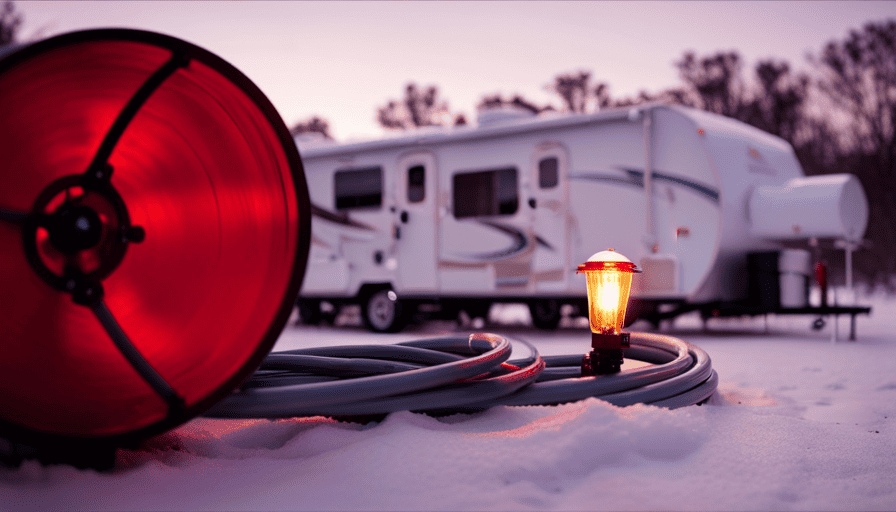Navigating the cold terrain of winter camping, protecting your camper’s water lines from freezing can feel like a daunting task. Similar to how a skilled knight protects their stronghold from invaders, we must also take measures to safeguard our vital water supply. Fear not, as I am here to offer you the expertise and tools required to conquer this icy adversary.
Imagine your water lines as delicate veins coursing through the heart of your camper, vulnerable to the frigid winds that seek to freeze them solid. To fortify these vital lifelines, we must first insulate them, shielding them from the cold’s icy grip. Heat tape or pipe heating cables can serve as valiant guardians, providing warmth to stave off the frost’s advances.
To further bolster their defense, install pipe insulation sleeves, fortifying your water lines against the relentless chill. And remember, a warm camper is a fortress against freezing. Utilize skirting or insulate the underbelly to keep the cold at bay. Open cabinet doors, allowing warm air to circulate and protect your water lines.
In the face of extreme cold, keep water running, for a moving stream resists the clutches of ice. And when the battle is won, disconnect and drain your water lines to prevent any lingering threats. In the darkest of winter nights, RV antifreeze becomes your trusty ally, safeguarding your water lines when all else fails.
With these tools and techniques at your command, you shall conquer the freezing depths of winter, ensuring your water lines flow freely and your camper remains a haven amidst the snow-covered landscape.
Key Takeaways
- Insulate water lines with heat tape or pipe heating cables to prevent freezing.
- Use pipe insulation sleeves and seal gaps with insulation tape for maximum efficiency.
- Keep the camper warm and insulate walls and ceiling to prevent heat loss.
- Skirt or insulate the underbelly of the camper to regulate temperature, improve energy efficiency, and protect water lines and components.
Insulate Your Water Lines
To keep your water lines from freezing in your camper, you’ll want to make sure you insulate them properly. Insulating your water lines is crucial to prevent heat loss and maintain a consistent temperature in your camper.
When it comes to energy efficient insulation options, there are a few choices to consider. One option is to use foam pipe insulation. This is a cost-effective and easy-to-install solution that provides excellent insulation properties. Simply measure the length of your water lines and cut the foam insulation to fit. Then, secure it in place using zip ties or duct tape.
Another option is to use heat-resistant fiberglass pipe wrap. This type of insulation is more durable and offers superior thermal protection. It can withstand higher temperatures and provides an extra layer of insulation for your water lines.
When insulating your water lines, it’s important to seal any gaps or openings with insulation tape to ensure maximum efficiency. Additionally, consider using a heated hose or heat tape to provide an extra layer of protection against freezing temperatures.
These DIY tips for insulating water lines in a camper will help prevent freezing and ensure a steady water supply during cold weather.
To transition into the next section about using heat tape or pipe heating cables, it is essential to take additional precautions to protect your water lines from freezing.
Use Heat Tape or Pipe Heating Cables
Using heat tape or pipe heating cables can help prevent your camper’s pipes from turning into frozen popsicles. These heating options are effective in preventing freezing by providing a constant source of heat to the water lines. Heat tape is a flexible, electrical heating element that can be wrapped around the pipes, while pipe heating cables are designed to be run alongside the pipes. Both options are easy to install and require minimal maintenance.
To illustrate the benefits of using heat tape or pipe heating cables, consider the following table:
| Heating Option | Pros | Cons |
|---|---|---|
| Heat Tape | Easy to install | Requires electricity |
| Pipe Heating Cables | Provides uniform heat distribution | More expensive than heat tape |
By using heat tape or pipe heating cables, you can ensure that the water lines in your camper remain free from freezing, even in cold weather conditions. These heating options provide a reliable solution for preventing frozen pipes and the potential damage they can cause.
In the next section, we will discuss how to install pipe insulation sleeves to further protect your camper’s water lines.
Install Pipe Insulation Sleeves
Ensure your camper’s pipes stay warm and protected from the chill by installing pipe insulation sleeves. Effective insulation techniques are essential to prevent pipe freezing and keep your water lines functioning properly in cold weather. Here are three reasons why pipe insulation sleeves are a great investment for your camper:
-
Thermal Protection: Pipe insulation sleeves provide a layer of insulation around your water lines, preventing heat loss and keeping the pipes warm. This helps to maintain a consistent temperature and prevents freezing, even in extremely cold conditions.
-
Energy Efficiency: By insulating your camper’s pipes, you can reduce heat transfer and minimize energy loss. Insulated pipes require less energy to keep the water warm, which can lead to cost savings on your energy bills.
-
Easy Installation: Pipe insulation sleeves are easy to install and can be customized to fit the size and shape of your camper’s pipes. Simply slide the sleeves over the pipes and secure them in place with adhesive or tape. This quick and straightforward installation process ensures that your water lines are protected in no time.
By properly insulating your camper’s pipes with insulation sleeves, you can prevent freezing and ensure a steady supply of water throughout the winter.
Now, let’s move on to the next section about how to keep your camper warm.
Keep Your Camper Warm
Stay cozy and comfortable in your camper during the winter months by implementing these tips to maintain a warm and inviting space. Efficient heating methods and energy-saving insulation techniques are essential for keeping your camper warm and preventing water lines from freezing.
One efficient heating method is to use a portable electric space heater. These heaters are compact and can easily be moved around to different areas of the camper. They provide instant heat and are energy efficient, making them a great option for keeping your camper warm without using a lot of electricity.
Another effective heating technique is to use a propane furnace. Propane furnaces are specifically designed for RVs and provide a consistent source of heat. They’re highly efficient and can be easily controlled to maintain a comfortable temperature inside your camper.
To further enhance the heating efficiency, consider insulating your camper’s walls and ceiling. This will help prevent heat loss and keep the cold air out. Use insulation materials such as foam boards or reflective foil insulation for maximum effectiveness.
Incorporating these efficient heating methods and energy-saving insulation techniques will ensure that your camper remains warm and comfortable during the winter months. To further protect your water lines from freezing, the next step is to use skirting or insulate the underbelly of your camper.
Use Skirting or Insulate the Underbelly
To combat the winter chill and maintain a cozy environment, why not consider skirting or insulating the underbelly of your camper? Here are four reasons why skirting can be beneficial:
-
Temperature regulation: Skirting creates a barrier between the ground and the underbelly of your camper, preventing cold air from seeping in and warm air from escaping. This helps maintain a more stable temperature inside the camper.
-
Energy efficiency: By reducing heat loss, skirting can significantly improve the energy efficiency of your camper. This means you can stay warm without relying too much on your heating system, saving you money on energy bills.
-
Protection from the elements: Skirting acts as a shield, protecting your water lines and other vital components from freezing temperatures, snow, and ice. This helps prevent costly repairs and ensures your camper remains in good condition.
-
Pest control: Skirting can also deter rodents and other pests from entering the underbelly of your camper, keeping your living space clean and free from unwanted guests.
When it comes to underbelly insulation, there are different types to consider, such as foam board insulation or spray foam insulation. Each type has its advantages, so it’s important to choose one that suits your specific needs and budget.
By skirting your camper and insulating the underbelly, you can create a warm and comfortable living space even in the coldest winter months. However, to further enhance the warmth, let’s explore the next step: using a space heater or heat lamp.
Use a Space Heater or Heat Lamp
Keep the winter chill at bay and transform your camper into a cozy oasis by adding a space heater or heat lamp.
When it comes to keeping your water lines from freezing in a camper, using a space heater or heat lamp can be an effective solution. However, it’s important to prioritize safety and energy efficiency when choosing these heating options.
When using a space heater, make sure to follow safety guidelines to prevent any accidents. Keep the heater at least three feet away from any flammable materials and never leave it unattended. Opt for a heater with a tip-over switch and overheat protection feature for added safety.
To maximize energy efficiency, choose a space heater with adjustable thermostat settings. This’ll allow you to maintain a comfortable temperature without wasting energy. Additionally, consider using a ceramic space heater, as they’re known to be more energy efficient compared to other types.
Another option is to use a heat lamp, which can provide targeted warmth to specific areas. Place the heat lamp near the water lines and insulate the area around it to trap the heat. This’ll help prevent freezing and ensure a steady flow of water.
In the next section, we’ll explore another method to keep your camper warm during winter – opening cabinet doors to allow warm air circulation.
Open Cabinet Doors to Allow Warm Air Circulation
Make sure you open cabinet doors in your camper to allow warm air to circulate and keep the interior cozy during winter. This simple step can make a big difference in preventing water lines from freezing. Here are three reasons why opening cabinet doors is essential for maintaining proper air circulation:
-
Improved heat distribution: When cabinet doors are closed, warm air can get trapped inside, leading to stagnant pockets of cold air. By opening the doors, you allow the warm air to flow freely throughout the camper, ensuring that every corner receives adequate heat.
-
Prevention of condensation: In cold weather, condensation can form inside closed cabinets, creating a damp environment. This moisture can increase the risk of mold and mildew growth, as well as damage any items stored inside. Opening the cabinet doors helps to reduce condensation by allowing air to circulate and keep the humidity levels balanced.
-
Accessibility to water lines: Opening the cabinet doors also makes it easier to access the water lines in case any maintenance or repairs are needed. This way, you can quickly address any issues and prevent them from escalating.
While opening cabinet doors is an effective method for maintaining air circulation, there are other alternative ways to prevent water lines from freezing in a camper. These methods include using insulation materials, installing heat tapes, or adding a skirt around the bottom of the camper to trap heat. These options provide additional layers of protection against freezing temperatures.
Now that you know how to improve air circulation in your camper, let’s move on to the next step: keeping water running in cold weather.
Keep Water Running in Cold Weather
As the winter chill settles in, you’ll want to ensure a steady flow of water in your camper, even in the coldest of temperatures. One effective way to prevent frozen pipes and keep water running in cold weather is by winterizing your camper. This process involves taking a few precautions to protect your water lines from freezing.
First, insulate any exposed water lines with foam pipe insulation. This will help retain heat and prevent the water inside from freezing. Additionally, consider using heat tape on particularly vulnerable areas, such as the water inlet and outlets. Heat tape is an electrical device that provides a constant source of heat, keeping the pipes warm.
Another important step is to ensure that your camper’s underbelly is properly insulated. This will help maintain a warmer environment for the water lines and reduce the risk of freezing. You can use insulated skirting or foam board to accomplish this.
Lastly, keep the water running in cold weather. Even a small trickle of water can help prevent freezing, as moving water is less likely to freeze than stagnant water. This can be done by leaving a faucet slightly open to allow a constant flow of water.
By following these steps and winterizing your camper, you can prevent frozen pipes and ensure a steady flow of water even in the coldest temperatures. Next, we will discuss how to disconnect and drain water lines when not in use to further protect your camper from freezing.
Disconnect and Drain Water Lines When Not in Use
To ensure your camper remains protected from freezing temperatures, it’s essential to disconnect and drain the water lines when they’re not in use.
Did you know that properly disconnecting and draining the water lines can help prevent costly repairs and damage to your camper? Here are some preventive measures and winterization techniques you can follow:
-
Turn off the water supply: Locate the main water shut-off valve and turn it off to stop the flow of water into the camper.
-
Open all faucets: Open all the faucets, including the shower and outdoor shower, to release any remaining water from the lines.
-
Drain the water heater: Attach a hose to the drain valve of the water heater and open it to drain out all the water.
-
Empty the fresh water tank: Use the drain valve or pump to empty the fresh water tank completely.
-
Blow out the lines: Use an air compressor with a blowout plug to blow out any remaining water from the lines.
By following these steps, you can ensure that your water lines are free from water and therefore less likely to freeze during cold weather. However, in extreme cold temperatures, it’s still advisable to use RV antifreeze for added protection.
Use RV Antifreeze in Extreme Cold Temperatures
Stay warm and worry-free during frigid winter months by using RV antifreeze to protect your cherished camper from the harsh effects of extreme cold temperatures. When the temperature drops significantly, it’s important to take extra precautions to prevent your water lines from freezing.
One alternative method is to use heated water hoses. These hoses are designed to keep the water flowing even in freezing temperatures. They have a built-in heating element that warms up the water as it flows through the hose, preventing it from freezing. This is a great option for those who frequently travel to areas with extremely cold temperatures.
Another important aspect of keeping your water lines from freezing is properly maintaining your RV’s water system. This includes regularly inspecting all the water lines for any cracks or leaks and repairing them promptly. It’s also crucial to insulate your water lines to minimize heat loss and prevent freezing. You can use foam pipe insulation or heat tape to wrap around the water lines and provide an extra layer of protection.
In addition to using RV antifreeze and alternative methods like heated water hoses, it’s essential to drain and disconnect your water lines when not in use. This ensures that no water is left in the lines, which can freeze and cause damage to the system.
By following these guidelines and properly maintaining your RV’s water system, you can enjoy a worry-free winter camping experience.
Frequently Asked Questions
How do I insulate my water lines in my camper?
To insulate water lines in my camper and prevent frozen pipes, I recommend using foam pipe insulation. This simple and effective solution can significantly reduce the risk of freezing. By wrapping the foam insulation around the exposed water lines, it creates a barrier against the cold temperatures.
This insulation helps to retain heat and keep the water flowing smoothly, even in freezing conditions. It’s a cost-effective and easy way to protect your water lines from freezing.
What is the purpose of using heat tape or pipe heating cables?
The purpose of using heat tape or pipe heating cables is to prevent water lines from freezing in a camper. These tools provide numerous benefits, such as maintaining a consistent water flow and preventing costly damage caused by frozen pipes.
Best practices for preventing water line freezing include properly insulating the pipes, installing heat tape or heating cables along the lines, and ensuring that the camper’s heating system is functioning efficiently.
How do I install pipe insulation sleeves in my camper?
To install pipe insulation in my camper, I start by measuring the length of the water lines and purchasing the appropriate size insulation sleeves.
Next, I cut the insulation sleeves to fit the pipes and slide them over the lines, making sure they’re snug and secure.
The benefits of using pipe insulation include preventing heat loss, reducing energy consumption, and protecting the pipes from freezing.
It’s a simple and effective way to ensure the water lines in my camper stay insulated and protected.
How can I keep my camper warm during freezing temperatures?
Ah, the joys of freezing temperatures and trying to keep my camper warm! To prevent the misery of frozen pipes and a chilly abode, there are a few things I do.
First, I insulate the windows and doors with weatherstripping to keep the cold air out.
Then, I use foam insulation boards to cover any exposed areas of the camper’s undercarriage.
Lastly, I make sure to use a space heater and electric blankets to keep cozy inside.
Now, onto the water lines…
Why is it important to use skirting or insulate the underbelly of my camper?
It is important to use skirting or insulate the underbelly of a camper for several reasons. Firstly, proper ventilation is crucial to prevent moisture buildup and condensation, which can lead to mold and mildew growth.
Skirting or insulating the underbelly helps to create a barrier that prevents cold air from infiltrating the camper, thus maintaining a warmer interior temperature.
Additionally, using foam board insulation provides added insulation and helps to prevent heat loss, resulting in energy savings and increased comfort.
Are the methods to keep camper pipes from freezing the same as keeping water lines from freezing in a camper?
Yes, the methods for keeping camper pipes from freezing are the same as keeping water lines from freezing in a camper. Proper insulation, using heat tape, and adding a heated water hose are effective ways of keeping camper pipes from freezing in cold temperatures.
Conclusion
In conclusion, preventing water lines from freezing in your camper is crucial for a comfortable and hassle-free camping experience.
By insulating your water lines, using heat tape or pipe heating cables, and installing pipe insulation sleeves, you can effectively protect your water system from freezing temperatures.
Additionally, keeping your camper warm, using skirting or insulating the underbelly, and opening cabinet doors for proper air circulation can help maintain a suitable temperature inside.
Remember, "an ounce of prevention is worth a pound of cure." So take the necessary precautions to ensure your water lines stay unfrozen and enjoy a worry-free camping trip.










